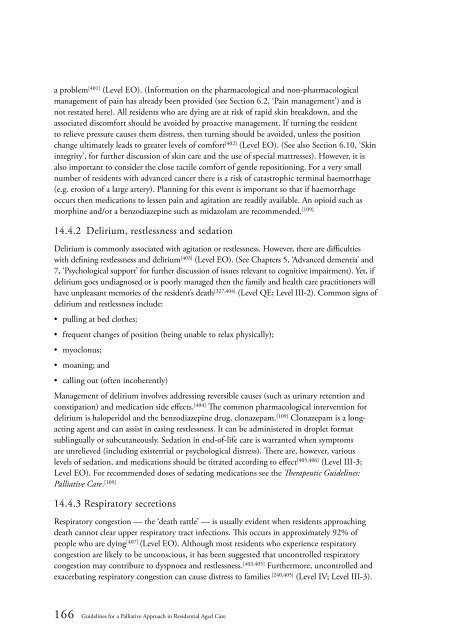Guidelines for a Palliative Approach in Residential Aged Care
Guidelines for a Palliative Approach in Residential Aged Care
Guidelines for a Palliative Approach in Residential Aged Care
Create successful ePaper yourself
Turn your PDF publications into a flip-book with our unique Google optimized e-Paper software.
a problem [401] (Level EO). (In<strong>for</strong>mation on the pharmacological and non-pharmacological<br />
management of pa<strong>in</strong> has already been provided (see Section 6.2, ‘Pa<strong>in</strong> management’) and is<br />
not restated here). All residents who are dy<strong>in</strong>g are at risk of rapid sk<strong>in</strong> breakdown, and the<br />
associated discom<strong>for</strong>t should be avoided by proactive management. If turn<strong>in</strong>g the resident<br />
to relieve pressure causes them distress, then turn<strong>in</strong>g should be avoided, unless the position<br />
change ultimately leads to greater levels of com<strong>for</strong>t [402] (Level EO). (See also Section 6.10, ‘Sk<strong>in</strong><br />
<strong>in</strong>tegrity’, <strong>for</strong> further discussion of sk<strong>in</strong> care and the use of special mattresses). However, it is<br />
also important to consider the close tactile com<strong>for</strong>t of gentle reposition<strong>in</strong>g. For a very small<br />
number of residents with advanced cancer there is a risk of catastrophic term<strong>in</strong>al haemorrhage<br />
(e.g. erosion of a large artery). Plann<strong>in</strong>g <strong>for</strong> this event is important so that if haemorrhage<br />
occurs then medications to lessen pa<strong>in</strong> and agitation are readily available. An opioid such as<br />
morph<strong>in</strong>e and/or a benzodiazep<strong>in</strong>e such as midazolam are recommended. [109]<br />
14.4.2 Delirium, restlessness and sedation<br />
Delirium is commonly associated with agitation or restlessness. However, there are difficulties<br />
with def<strong>in</strong><strong>in</strong>g restlessness and delirium [403] (Level EO). (See Chapters 5, ‘Advanced dementia’ and<br />
7, ‘Psychological support’ <strong>for</strong> further discussion of issues relevant to cognitive impairment). Yet, if<br />
delirium goes undiagnosed or is poorly managed then the family and health care practitioners will<br />
have unpleasant memories of the resident’s death [327,404] (Level QE; Level III-2). Common signs of<br />
delirium and restlessness <strong>in</strong>clude:<br />
• pull<strong>in</strong>g at bed clothes;<br />
• frequent changes of position (be<strong>in</strong>g unable to relax physically);<br />
• myoclonus;<br />
• moan<strong>in</strong>g; and<br />
• call<strong>in</strong>g out (often <strong>in</strong>coherently)<br />
Management of delirium <strong>in</strong>volves address<strong>in</strong>g reversible causes (such as ur<strong>in</strong>ary retention and<br />
constipation) and medication side effects. [404] The common pharmacological <strong>in</strong>tervention <strong>for</strong><br />
delirium is haloperidol and the benzodiazep<strong>in</strong>e drug, clonazepam. [109] Clonazepam is a longact<strong>in</strong>g<br />
agent and can assist <strong>in</strong> eas<strong>in</strong>g restlessness. It can be adm<strong>in</strong>istered <strong>in</strong> droplet <strong>for</strong>mat<br />
subl<strong>in</strong>gually or subcutaneously. Sedation <strong>in</strong> end-of-life care is warranted when symptoms<br />
are unrelieved (<strong>in</strong>clud<strong>in</strong>g existential or psychological distress). There are, however, various<br />
levels of sedation, and medications should be titrated accord<strong>in</strong>g to effect [405,406] (Level III-3;<br />
Level EO). For recommended doses of sedat<strong>in</strong>g medications see the Therapeutic <strong>Guidel<strong>in</strong>es</strong>:<br />
<strong>Palliative</strong> <strong>Care</strong>. [109]<br />
14.4.3 Respiratory secretions<br />
Respiratory congestion — the ‘death rattle’ — is usually evident when residents approach<strong>in</strong>g<br />
death cannot clear upper respiratory tract <strong>in</strong>fections. This occurs <strong>in</strong> approximately 92% of<br />
people who are dy<strong>in</strong>g [407] (Level EO). Although most residents who experience respiratory<br />
congestion are likely to be unconscious, it has been suggested that uncontrolled respiratory<br />
congestion may contribute to dyspnoea and restlessness. [403,405] Furthermore, uncontrolled and<br />
exacerbat<strong>in</strong>g respiratory congestion can cause distress to families [240,405] (Level IV; Level III-3).<br />
166 <strong>Guidel<strong>in</strong>es</strong> <strong>for</strong> a <strong>Palliative</strong> <strong>Approach</strong> <strong>in</strong> <strong>Residential</strong> <strong>Aged</strong> <strong>Care</strong>
















